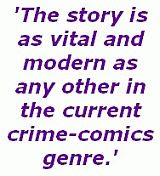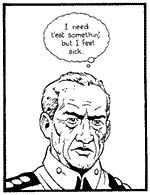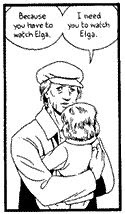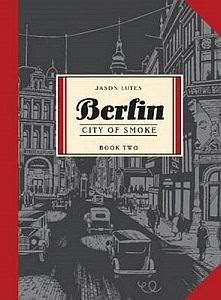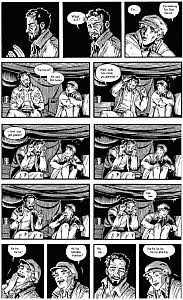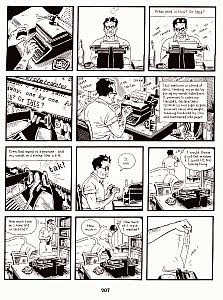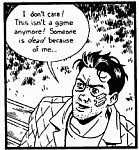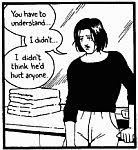Jon Scieszka's Time Warp Trio Series, Learning History and Culture can be Fun
by Steven Williams
The Time Warp Trio is a series of stories written by Jon Scieszka, originally illustrated by Lane Smith and later illustrated by Adam McCauley, which chronicles the adventures of three boys - Joe, Sam, and Fred - who travel through time and space. Scieszka is notable for his ability to attract reluctant readers and this series is a successful effort in this direction.
Plot
The boys' traveling of time is accomplished with the help of a strange blue book simply referred to as The Book, which was given to Joe as a birthday present from his uncle Joe the Magnificent, an amateur magician. After accidentally activating The Book, the boys are transported to medieval times and must help fight towering beasts such as a giant and dragon. From then on they continue to be transported from one time period to the next. In one adventure they travel to year 2095 and meet their own great-granddaughters who have The Book in their time along with the knowledge to control it. The boys present time home is in Brooklyn, New York.
The books have been adapted into an animated television series.
Characters
Joseph "Joe" Arthur - A 10-year old who wants to be a magician, but can only perform the simplest tricks in the book. He got The Book for his birthday from his uncle and namesake, "Joe the Magnificent". As a bad habit, he takes The Book everywhere with him, causing even the slightest wrong action or phrase to activate it. He lives with his father, an archaeologist, his mother, and his little sister, Anna.
Sam - Joe's 10-year old friend who is wary of time traveling. He wants to become a great inventor, but has great difficulty. Sam is lactose intolerant.
Fred - Joe's other 10-year old friend. He has a big brother who beats him and destroys his video games. His ignorance often causes he and his friends to get into trouble.
Joe the Magnificent - Joe's uncle who tries to be a magician, but fails at live performances. He believes in the Tooth Fairy and Easter Bunny, said in book 7. He sent his nephew The Book (which he couldn't use either). He travels with an enchanted pocket watch.
Mrs. Arthur - Joe's mother who is short-tempered and is prone to shouting out Joe's full name in frustration. She knows of The Book and was the one who showed Joe the page that would allow the boys to choose the specific time they visit. She was also the one who showed her brother Joe the Magnificent how to use The Book.
Anna Arthur - Joe's younger sister, a very annoying girl in Joe's opinion. She has more knowledge concerning The Book than her brother.
Jodie Arthur, Samantha (sometimes called Samza), and Freddie (Frieda is her full name) - Joe, Sam, and Fred's great-granddaughters, respectively. Originally from the year 2095, they occasionally are in the same time and place as their great-grandfathers. They seem to be able to control The Book at will.
Books
Knights of the Kitchen Table
The Not-So-Jolly Roger
The Good, the Bad, and the Goofy
Your Mother Was a Neanderthal
2095
Tut Tut
Summer Reading Is Killing Me
It's All Greek to Me
See You Later Gladiator
Sam Samurai
Hey Kid, Want to Buy a Bridge?
Viking It and Liking It
Me Oh Maya
Da Wild, Da Crazy, Da Vinci
Oh Say, I Can't See
Marco? Polo!
The Knights of the Kitchen Table (May, 1991)This first of Scieszka's
Time Warp Trio series. The premis for this series is that three gradeschool age best friends, Joe, Fred, and Sam, have time travel adventures brought on by their encounters with
The Book. Joe receives a book as a gift from his magician uncle. It turns out to be no ordinary book though. They discover by chance that
The Book has the power to send them back in time. In this first adventure,
The Book sends them back to the time of King Arthur's Britain. The first person they encounter is the dreaded Black Knight. They are able to dodge his charges and quickly earn a reputation as heroes. They add to their reputations by tricking a giant into taking on a terrible dragon that has turned up. They manage to outwit the villains and, despite the mixups created by the differences of language and dress, use their daring and quick thinking and to get back home.
The Not-So-Jolly Roger (May, 1991)Joe, Fred, and Sam are back in the second
Time Warp Trio adventure. Almost immediately
The Book sets them down in a coconut tree surrounded by pirates. They are Blackbeard's crew and they are given the choice to either join the crew, walk the plank, or become the primary ingrediant in a coconut stew. Blackbeard had come her to bury some treasure and the bodies of the two crew members he brought with him to do the work. The three boys finally figure out how to get
The Book to take them back home.
The Good, the Bad, and the Goofy (May, 1992)In their third adventure, the
Time Warp Trio end up in the Old West on the Chisholm Trail in 1868 where they are soon soon range ridin' and cow punchin'. The quickly discover that between the work and the food, the life of a cowboy is not so great life after all. Then to top it off, Indians show up. All in all, their adventures include escaping two stampedes, a flash flood, being scalped by Cheyenne Indians, and a charge of the Seventh Cavalry lead by Custer. In the end, Sam's knowledge of history along with some magic spells finally get the three boys back home.
Your Mother Was a Neanderthal (May, 1993)The fourth
Time Warp Trio adventure is set in prehistoric times. There are the usual assortment of Stone Age inhabitants and artifacts including a saber-toothed cat, a woolly mammoth, cave paintings, and a collection of cavemen, women, and girls. Besides the reality of their predicament, this time they do not have
The Book with them. In previous adventures it has held the key, in some way, to help get them back home. To top this off, they start out their adventure naked. With quick thinking the boys 'invent' clothing and, with the help of some simple physics involving a fulcrim and a lever, save the day.
2095 (April, 1995)The fifth
Time Warp Trio is a sort of change from the others in that instead of sending the three into the past,
The Book transports them one hundred years into the future. Once there there are the usual mis of threats and adventures, this time including hostile robots, incredibly inflated prices, levitating footwear, and not too distant relatives. They are launched into the future while they are visiting the Natural History Museum and in the future version of museum they almost immediately find themselves in front of the 1990s exhibit. They also encounter their great-grandchildren, who quickly are enlisted in trying to return the three boys to the past.
Tut, Tut (August, 1996)In the sixth
Time Warp Trio adventure the three heroes find themselves back in ancient Egypt. While there, they encounter mummies, crocodiles, tomb robbers, the Sphinx, and other oddities. The villain this time is the pharaoh's evil priest who they have to avoid while at the same time looking for
The Book so that they can get back home. There are additional complications for the three this time in that they are also looking for Joe's little sister and her cat who somehow ended up being transported back in time by
The Book also.
Summer Reading Is Killing Me (July, 1998)The seventh of the time travel adventures begins with Joe, Fred, and Sam being transported to a playground. Joe recognizes a 250-pound chicken, the Hoboken Chicken, headed for them from a book he had just read. It turns out that since Fred put their summer reading list inside
The Book and they are caught spending their summer living out a bizarre mix of all the stories they are supposed to be reading. A maniacal Teddy Bear becomes the leader of the bad characters from the reading list books. Soon, the bad characters are trying to knock off all othe good characters: Homer Price is being carried away by the Headless Horseman, Dracula is dragging off Winnie the Pooh, and Mr. Twit is breaking Harold's Purple Crayon. The three heroes set off to find
The Book both to get back home and to save children's literature from being destroyed. Our three heroes at first are able to infiltrate the band of book villains by masquerading as villains from an action-adventure series. They are soon found out though but at the same time, with a little help, are able to find
The Book and set things right.
It's All Greek to Me (October, 1999)This is the eighth title Jon Scieszka's
Time Warp Trio series. This time the three friends Fred, Sam, and Joe, the narrator, are taking part in a school play they co-wrote about the ancient Greek gods and Mount Olympus. Suddenly, 'The Book', the magic book given to Joe by his magician uncle transports the three boys into Hades, the ancient Greek underworld. The only resources they have are props from the play: a fake thunderbolt and a spray-painted golden apple. The first thing that happens is they must confront Cerberus, the slavering, three-headed dog guarding the gates. Using their wits and a Ding dong, they escape from Hades, and go on to Mount Olympus hoping to find 'The Book' there so that they can get back home. Instead of finding the magic book though, they become involved in an increasingly dangerous series of disagreements with the wise-cracking, bickering Greek gods.
Children who know Nike is the Greek goddess of victory will double over with laughter when Sam Orpheus, friend of Nike, introduces his chums as Fred Cyclops, follower of Reebok, and Joe Paris, cohort of Fila. Humor continues as the friends help hide a nervous Zeus, who is worried that his wife, Hera, will blab to the other gods if she finds out he lost his thunderbolts. Dionysus wants to party and Ares wants to fight, but the real trouble starts when Zeus challenges Joe to give his golden apple to the fairest of all goddesses.
oe, Fred, and Sam are horsing around during their school playwhich they wrote themselvesabout the ancient deities of Greece. When a cardboard thunderbolt accidently hits the magic blue book stashed in Joe's backpack, the three boys are transported back to ancient Greeceor so they think. When they meet some of the wisecracking gods and goddesses on Mount Olympus, they realize they've been transported to the fictionalized Greece of their play, complete with dialogue they wrote using ``The Book of Snappy Insults.'' While flinging around backhanded compliments with Hera (who's not bad on the uptake), the three time travelers try to locate their blue book of magic so they can return home. Instead, they end up as that night's entertainment for the gods. The opening jokes fall flat, but then Joe comes up with some last-minute parlor tricks. Just when everything's going well, a pack of Greek monsters arrives, and the mountain top threatens to become a battlefield.
resources
Adam McCauley artist website
http://www.atomicalley.com/home.html
Jon Scieszka website
http://www.jsworldwide.com/
Lane Smith artist website
http://www.lanesmithbooks.com/
Time Warp Trio website
http://www.timewarptrio.com/
Time Warp Trio at Wikipedia
http://en.wikipedia.org/wiki/Time_Warp_Trio
Time Warp Trio page at Discovery Kids
http://kids.discovery.com/fansites/timewarptrio/timewarptrio.html
The Time Warp Trio animated series
Time Warp Trio is an animated television series, based on a series of children's books written by Jon Scieszka and illustrated by Lane Smith. Produced by Soup 2 Nuts in association with WGBH Boston, the show airs on Discovery Kids but also aired in a two-hour Discovery Kids block on NBC until September 2, 2006. The show still airs daily on the Discovery Kids Channel in the USA, and on CBBC in the United Kingdom.
Plot
When Joe receives a mysterious book from his uncle on his 10th birthday, he has no idea what is in store for him and his two best friends Sam and Fred. Every time they open this book - known as The Book - it transports them through time into different time periods, causing them to get into dangerous situations. Whether they like it or not, they have to find the book in the time period they're in while trying to stay alive.
The boys learn how to use The Book throughout the series, but end up warping by triggering the book accidentally. Their great-granddaughters from the 22nd century know how to use The Book at will, although they sometimes trigger it accidentally as well. Samantha has a pocket-watch that belonged to Sam that can go back in time and to the future, although it has been known to break a couple of times and not go into the future even if stuck in the past.
Later in the series, Joe's evil uncle, Mad Jack, tries several attempts to capture the children with his crafty tricks. Whether it's stranding the boys in Antarctica, or trying to make their new home China, Mad Jack can be ruthless when it comes to The Book.
Characters
Joe is an up-and-coming Indian American magician and the owner of The Book in 2005. His talent for magic helps the trio in tough situations, but his tricks can also lead to some hilarious mishaps. As the unofficial leader of the group, Joe often has to settle disputes between Fred and Sam. He also has an amazing ability to talk his way out of trouble, which is why he hates to be outsmarted! However, many times he'll try to get out of a tight spot with his magic tricks, which are currently poor. One day, however, Joe is said to become a warp wizard. Eventually, he is awarded the title of Time Page, a title that Jodie mistakenly says she hadn't been since she was five, though this is not true as she said in the episode 2105 she got the book from her uncle on her 10th birthday, making it impossible to have had it when she was only five. According to Freddi and Jodie, Joe will fight his uncle, Mad Jack, in a great battle that will determine the fate of time itself.
Sam is a Russian American coward. Sam uses book smarts, calculations and research to get himself, along with Fred and Joe, out of harm's way. Even though his ideas and expansive knowledge of history help the group escape several scary situations, he still worries that the gift of knowledge makes him a bit of a nerd. Sam is also very wary of time travel, and he's convinced their doom is imminent every time they open The Book. According to Freddi, Sam will invent something important in the future, but she won't tell him what (she almost does, but The Book takes her back to her own time before she does; she said to Sam "You're going to figure out a way to..."). Sam is lactose intolerant.
Fred is a 10-year old American sports fan who isn't the brightest bulb on the chandelier. He has a big brother who bullies him. Although he does deserve it some times by messing with Mike's video games and other things. His stupidity often ends up getting the gang in trouble, and always wants to persuade his two other friends, Joe and Sam, to travel somewhere via The Book where they can gain riches, glory or credit for something in a time period they didn't do. Even though he leaps before he looks, Fred uses it as an advantage to fight enemies and save the trio from trouble or death. At the beginning of an episode when Joe or Jodie are talking about how they got where they are, they mostly blame it on Fred.
Mike - Fred's mean brother. Is always horrid to Fred, but Fred does stand up to him after 'See You Later, Gladiator.' Mike has a farting problem.
Joe the Magnificent - A.K.A. - Uncle Joe. Joe's maternal uncle who is a magician, but not so great. He gave his nephew The Book (which he couldn't use that well either). Seconds after Joe received The Book, his uncle vanished. He has other means of travelling through time, though seems to suffer from the same lack of control over these methods as he did over The Book.
Mad Jack - Joe the Magnificent's evil brother who is intent on getting his hands on The Book so that he can rule all of Time and Space. He recently faced a showdown with his nephew Joe and tried to get The Book in which he never succeeds. Mad Jack does not appear in the book series. In every episode, even before Mad Jack is known to the boys, the evil man is somewhere watching the kids, usually in a crowd. He is often hard to find.
Joe's Mom - Joe and Anna's mom; Joe the Magnificent and Mad Jack's sister.
Anna - Joe's younger sister, a very annoying girl in Joe's opinion. She often travels with the boys or uses The Book without permission, to Joe's anger. However, Anna is a very skilled warper herself and can handle The Book a little better than her brother. She is an owner of a zebra named Stuffie.
Jodie - Joe's great-granddaughter from 100 years in the future. Jodie is a third level warper and doesn't like being taken out of her comfort zone. She is sometimes selfish and even a little mean, but can also be kind. She is bossy and loves fashion, and can be lazy at times. She looks a lot like Joe's sister, Anna. She lives in the year 2105 along with her friends Freddi and Samantha. Jodie is also prone to complaining and allergic to cats.
Samantha - Sam's great-granddaughter from the year 2105, 100 years in the future from 2005, the year the boys live in. She can be a bit clumsy and loves her robot cat, Rivites. She sometimes teases jokingly and is shown to be daring and almost the opposite of her friend Jodie, and even her great-grandfather Sam. She owns a pocket watch that once belonged to Sam, though in the series he does not have a pocket watch yet. He could have invented it himself, but this is not sure and is just a guess.
Freddi - Fred's great-granddaughter from the year 2105. She is very kind to all, and can sometimes be quite nervous and hesitant. She has a fear of heights, and in the books she is shown to love baseball, even wearing a futuristic baseball cap, though in the TV show it is unknown if she does. Freddi from the books is a lot different from Freddi from the show, a girl version of Fred, the biggest difference about the kids from the books and the kids from the TV shows. Also in the books, Freddi and Samantha were very similar, so the change for the TV shows was probably because of that.
The boys first met the girls in the episode 2105, the girls having found a note that the boys will write for them at the end of the episode. They become friends, and afterward the girls are in many shows.
Episodes
The Not-So-Jolly Roger - The boys' first adventure with the book where they accidentally join the crew of the pirate, Blackbeard.
2105 - The boys warp 100 years into the future and meet... their great-granddaughters. (First appearances of Jodie, Samantha and Freddi.)
You Can't, But Genghis Khan - When Sam throws a Mongolian menu into The Book, the boys almost get turned into roadkill and meet the boy who will grow up to become Genghis Khan (Temüjin).
Tut, Tut - Anna warps the boys back to Ancient Egypt, where they meet a Pharaoh and find themselves almost being mummified.
Sam Samurai - The boys warp back to Japan and get involved in a battle. The girls turn up just in time to save their lives, but then Sam and Samantha get separated from the others when The Book warps them away.
See You Later, Gladiator - The boys warp to ancient Rome and are almost forced to fight a gladiator.
Lewis and Clark... and Jodie, Freddi and Samantha The girls accidentally warp into 1800 wilderness.
Viking it and Liking it - The boys help Leif Eriksson discover America.
Hey Kid, Want to Buy a Bridge? - The boys warp back in time to when the Brooklyn Bridge gets built to help Sam make an invention.
Me Oh Maya - The boys warp back to an ancient Mayan civilization and interrupt a sacred game.
The Good, the Bad, and the Goofy - The trio is warped back to the time of the Indians and the "cowboys". Although Joe and Fred are disappointed when they find out that cowboys aren't exactly who they think they are. After a frantic bull charge the boys get stuck an Indian camp. Their fate must be decided, whether they live or die.
Able Was I Ere I Saw Elba - When Joe accidentally says a palindrome, he and Fred, along with Samantha, accidentally change history by having Napoleon win the Battle of Waterloo, as they discover on returning to the present which is radically different from how they left it; America is now called New France and everyone speaks French. The boys must return to the past to ensure that history takes its proper course.
The Seven Blunders of the World - A weird man steals The Book and plots to rule the world with it. However, someone else also has the same plans...
Jinga All the Way - When Fred stabs The Book, he, Sam and Jodie warp to Africa.
Birdman or Birdbrain? - Samantha, Fred and Freddi warp to Easter Island when the contents of The Book become a strange language.
Dude, Where's My Karma? - Fred and Sam intervene when Mad Jack tries to kill Joe's ancestor so he will never be born. (First Appearance of Mad Jack)
My Big Fat Greek Olympics - Fred accidentally warps himself and Samantha to the Greek Olympics.
Wushu Were Here - Fred, Joe and Anna warp to China to find a way to free Sam, who has become trapped inside The Book.
What's So Great About Peter? - Fred convinces Sam and Samantha to go back in time to Russia to look for a family fortune.
The Caveman Catastrophe - On a visit to the Stone Age, Sam, Fred, and Jodie get turned into Neanderthals after accidentally changing events there. The only way for them to return to normal is to discover the reason behind the change and ensure that history is set straight.
Nightmare on Joe's Street - Frankenstein's Monster gets unleashed in Joe's kitchen after the creature mysteriously turns up in the hall closet, while a quest to the past by Joe, Sam and Jodie to find Mary Shelley results in Count Dracula turning up as well!
Breaking the Codex - The kids have to save Leonardo Da Vinci from Mad Jack.
Break an Egg - Mad Jack attempts to trap the boys in Antarctica during Robert F. Scott's 1911 expedition.
The High and the Flighty - Jodie, Samantha and Freddi warp back in time to try to find out what happened to Amelia Earhart, and try to prevent her disappearance.
Harem Scare'em - The kids warp to the Ottoman Empire to find the Time Map.
Plaid to the Bone - Joe, Jodie and Anna are forced to help a castle from an invasion.
Production
On July 15, 2006, Time Warp Trio aired the last first-run episode of the season on the Discovery Kids Channel. A marathon was held on this day, which was also made up of six other first-run episodes. On September 2, 2006, Time Warp Trio aired its last first-run episode of the season on NBC, which was also the ending of the "Discovery Kids on NBC" block. No new episodes of Time Warp Trio have been aired since then, and the official website hasn't reported if any new episodes will be airing at all. Despite this, TV.com blogs state that a movie and new season is expected, it appears that the show is on hiatus. Members of the Time Warp Trio at TV.com forums have been asking people in WGBH, Soup2Nuts and PBS about if and when a second season would be produced and aired, but only got a non-committed response. As of 2009 it is unknown if the show is still in production.
Graphic Novels based on the animated series
Nightmare on Joe's Street
The Seven Blunders of the World
Plaid to the Bone
Meet you at Waterloo (Able was I, ere I saw Elba)
Chapter Books based on the animated series
You can't, But Genghis Khan
Lewis and Clark...and Jodie, Freddi, and Samantha
Wushu Were Here
Newer Article: The Fall by Brubaker and Lutes, A Review by Nick Brownlow
Home
Newer Article: Camera Obscura, Writing and Reading with a Pulp Sensibility


